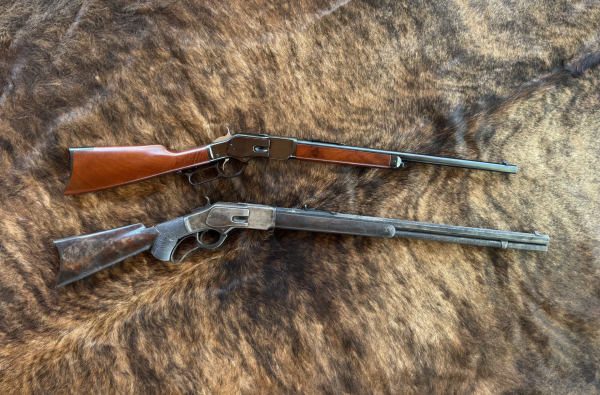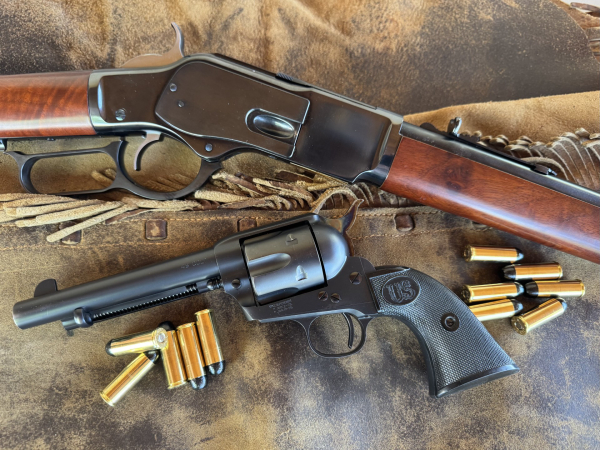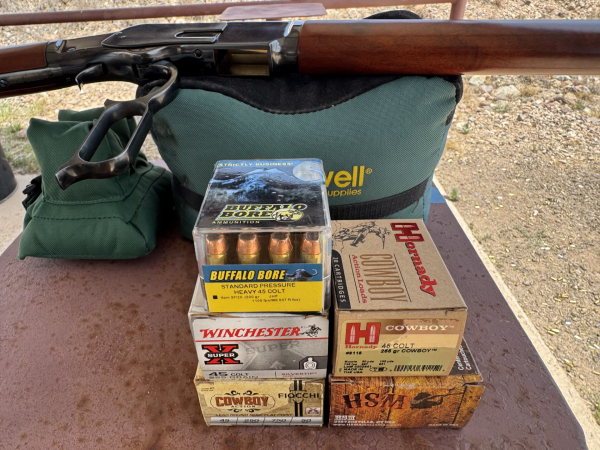By Shane Jahn

If you believed everything you saw in the motion picture and television westerns of the 1950’s and 60’s you’d think Winchester’s Model 1892 carbine was the lever gun that won the West, and you’d be wrong, sort of. From 1873 to 1919, which covers a good portion of the period of what we know as the “Old West,” Winchester produced over 720,000 of the Model 1873 lever-action chambered in .32-20 (.32 WCF), .38-40 (.38 WCF), and .44-40 (.44 WCF) and even a few in .22 Long and .22 Short calibers. The .44-40 was the favored cartridge. Transitioning from the brass framed Winchester Model 1866, Winchester’s Model 1873 was first introduced in the new, more powerful .44 WCF that consisted of a 200-grain lead flat nose bullet atop 40 grains (.44-40 = .44 caliber and 40 grains of black powder) that zipped along at 1200 fps or better out of a 24-inch barrel. The stouter frame of the Model ‘73 was first made of iron and then transitioned to steel in the early 1880’s.
The ‘73 Winchester was used widely by lawmen, outlaws, Indians, cow punchers and outdoorsmen. Model 73’s road in saddle scabbards across the country and were used to feed hungry pioneers and in combat with hostile native tribes, outlaws and bandits. James Gillett joined the Frontier Battalion of the Texas Rangers in 1875 and patrolled the Lone Star State covering an estimated 10,000 miles horseback during his 72-month tenure with that adventurous outfit. In December of that year, he purchased a Model ‘73 Winchester carbine in .44-40 and carried it during his numerous exploits across the frontier where he fought Apaches, Comanches, Kiowas, and various outlaws and cattle rustlers. Gillett kept record of some of the wild game he killed with the carbine and noted that from December 1876 to April 1877 he brought in 12 javelina, 27 deer and 77 wild turkeys to feed himself and fellow rangers. His good book, Six Years with the Texas Rangers, is an interesting read for those fascinated about those early days on the Texas frontier.
It’s safe to say that the ‘73 Winchester was the AR-style rifle of its day. Staying with our lawman theme of the moment, the man honorably known as “The First Border Patrolman”, Jeff Milton, toted a Winchester Model 73 in .44-40 early in his long law enforcement career, his first being a Texas Ranger in west Texas in the 1880s. Of course, men who rode on the other side of the law favored the ’73 as well. It’s the rifle in the famous photo of the infamous Billy the Kid. Another well-known photo shows the Apache leader, Geronimo, standing with three of his warriors, two of which are holding Model ’73 lever guns. History also shows that while the ill-fated 7th Cavalry was armed with single-shot trapdoor Springfields in .45-70 for long arms and Colt Single Action Army revolvers, some of their adversaries had repeating rifles. In fact, the Indians used a variety of weaponry, from bows and arrows to muzzle loaders, and more modern lever guns. It’s said that archaeological evidence has shown that a few of the Native Americans were even firing 1873 Winchesters during the Battle of Little Bighorn.
The Winchester Model 1873 saw military action elsewhere, and some will be surprised to know it played a critical role in the 1877-78 Russo-Turkish War. Gordon Rottman’s e-book, The Big Book of Gun Trivia: Everything you want to know, don't want to know, and don't know you need to know about weapons, explains that the Ottoman Empire purchased 30,000 Model ‘73s in .44-40. The Turks used them with great effect to combat advancing Russian troops by taking advantage of the rapid-fire qualities of the lever-action rifles against the massed formations of troops. With the aid of the Winchesters, over 20,000 Russians were lost during two bloody attacks.
The Model ‘73 came in a variety of configurations, including muskets with extended forearms, rifles, and carbines. Some had barrel-length magazine tubes, some had the shorter half-magazine tubes, and some had the button magazine that stops at the forearm. Additional options such as round barrels and octagonal barrels, takedown models, straight grips and curved grips and optional finishes were available as well. For anyone who wants to know all there is to know about Winchesters, George Madis’ book, The Winchester Handbook, is a must. Those Winchester Center Fire (WCF) cartridges listed above led to the good notion of using a handgun chambered in the same cartridge as one’s rifle and that compatibility was provided by Winchester and the equally famous Colt Single Action Army revolver chambered in the same cartridges. Another compatible option offered to a lesser extent was Remington’s models 1875, 1888, and 1890 revolvers that were chambered in .44-40.

Many of these original lever actions are still around and most samples will show hard use proving just how much they were carried aboard a horse, handled, shot, and used daily. Of course, there are still those in existence that are in excellent condition that bring a premium, and you can find a variety to fit your budget on GunBroker. It is important to note that not all original Winchester Model 1873s are the same and it’s imperative to remember the ’73 lever gun was born in the age of black powder cartridges and transitioned into the new world of smokeless powders. It’s wise to do a bit of research to see when the gun was made prior to firing it and treat it accordingly.

The internet is littered with opinions of the mechanical strength, more specifically lack thereof, of the Model 1873’s toggle link action. Mike Venturino, in his book, Shooting Lever Guns of the Old West, suggests no original (old) Winchester should ever be fired before being examined by a gunsmith who is knowledgeable in antique firearms. That’s good advice for a variety of old guns. He goes on to suggest that ‘73s made earlier than around serial number 541,000 (prior to the year 1900) are best left to be fed by black powder cartridges. He would fire those made after 1900 with smokeless powder loads that are safe to be fired in Colt Single Action Army-styled revolvers. The toggle link lock up of the Model 1873 action is reported to be less robust than others like the Winchester Model 1892-style action or Marlin’s 1894. It’s wise to use common sense and standard pressure loads in 1873-styled lever guns and enjoy their mild recoil. If you want high-pressure, barnburners move on to a stronger lever action platform, and if you don’t know always consult the manufacturer for advice. Some of today’s modern Model ‘73s are chambered in stout cartridges like the .357 Magnum and even the .44 Magnum. John Taffin wrote that the Uberti .44 Mag underwent special heat treatment and utilized stronger steels to handle the magnum round. I’ve not handled one chambered in a magnum cartridge. Personally, I will err on the side of caution and only run standard loads in Model ’73 lever guns.
Cimarron Firearms provided their 1873 John Russell model that was inspired by the classic western movie, Hombre. John Russell is the character played by Paul Newman who carries a rifle like this one. The film has a classic gunfight scene at the end that is a must see for cinema gun buffs. This Cimarron lever gun features a heavy 20-inch barrel measuring 0.89 -inch at the frame and 0.77-inch at the muzzle. It has a short button magazine that holds six cartridges, a crescent butt plate and is chambered in .45 Colt. Fit and finish on this rifle are excellent and the action is slick. The metal is deep Charcoal blue, and the red-stained wood of the stock and forearm have a bit of grain in them that looks nice. Three shot groups were fired at 25 yards withammunition from Buffalo Bore, Fiocchi, Hornady, HSM, and Winchester. The groups averaged just over 1.5 inches, oftentimes with two holes touching. This rifle will make a neat hunting gun and is up to the challenge of bringing pork and venison to bear at reasonable distances. I’m sure the cowboy action crowd would find it handy for ringing steel as well.
All of this about the Model’73 is not meant to take anything away from the Model ’92 mentioned at the beginning of the article, or Winchester’s Models 1876, 1886, 1894, and 1895 for that matter. They all had a hand in settling the frontier. It’s probably more appropriate to say, “Winchester’s Lever Actions Won the West.” As a matter of fact, things stayed pretty “wild and western” in the southwestern United States into the 1930s, especially along the Mexican border. We’ll cover some of these other guns later this year in The Lever Gun Chronicles here on The Hunting Wire. Today you can still get a Model ’73 chambered in modern cartridges and some of the originals. Good companies like Cimarron Firearms, Taylor’s & Company, Uberti, and Winchesteroffer a variety of configurations of the Model 1873. It might not be the only gun that won the west, but it is definitely one that helped tame it!